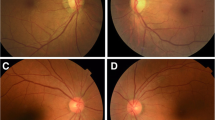Abstract
Background
Vertical strabismus can be modulated by the viewing distance. We report on 19 patients with this disorder.
Methods
The following squint angles were measured by the alternate prism and cover test at a viewing distance of 5 m. At 0.3 m, measurements were taken with and without an addition of 3.0 D to the corrected refraction. Cases of a dissociated vertical deviation were excluded. Fifteen patients underwent surgery. They were reexamined 3 months later.
Results
At a viewing distance of 5 m, the vertical deviation ranged from 0° to 16° (median 7°). At 0.3 m, the deviation increased by 2°–15° (median 7°) in 15 patients and decreased by 3.5°–8° (median 4.5°) in 4 patients. Eleven patients had a strabismus sursoadductorius and one had a strabismus deorsoadductorius. Eye muscle surgery reduced both the vertical deviation for distance fixation to 0°–14° (median 2°) and the difference between the deviations for distance and proximal fixation to 1°–6° (median 3°).
Conclusions
In certain cases, vertical strabismus can be modulated by convergence and accommodation. This condition is frequently associated with an incomitance of the vertical deviation in side gaze. The baseline deviation can be reduced by appropriate eye muscle surgery. In cases of vertical accommodative vergence, bifocal glasses can be helpful.

Similar content being viewed by others
References
Bielschowsky A (1930) Die einseitigen und gegensinnigen (“dissoziierten”) Vertikalbewegungen der Augen. Graefes Arch Ophthalmol 125:493–553
Bielschowsky A (1938) Disturbances of the vertical motor muscles of the eyes. Arch Ophthalmol 20:175–200
Clark RA, Miller JM, Demer JL (1998) Displacement of the medial rectus pulley in superior oblique palsy. Invest Ophthalmol Vis Sci 39:207–212
Demer JL, Miller JM (1995) Magnetic resonance imaging of the functional anatomy of the superior oblique muscle. Invest Ophthalmol Vis Sci 36:906–913
Graf M (1993) Three cases of vertical accommodative vergence. Klin Monatsbl Augenheilkd 202:136–137
Graf M, Weinand K (2000) Vertical deviation coupled to convergence. Klin Monatsbl Augenheilkd 216:51–53
Hara N, Steffen H, Roberts DC, Zee DS (1998) Effect of horizontal vergence on the motor and sensory components of vertical fusion. Invest Ophthalmol Vis Sci 39:2268–2276
Klein-Scharff U, Kommerell G (1991) Vertical accommodative vergence. Klin Monatsbl Augenheilkd 199:344–345
Leigh RJ, Zee DS (1999) The neurology of eye movements. Oxford University Press, New York, pp 286–318
Mattheus S, Kommerell G (1996) Reversed fixation test as a means to differentiate between dissociated and non-dissociated strabismus. Strabismus 4:3-9
Noorden GKv., Campos E (2002) Binocular vision and ocular motility. Theory and management of strabismus. Mosby, St. Louis, pp 377–395
Schor CM, McCandless JW (1995) An adaptable association between vertical and horizontal vergence. Vision Res 35:3519–3527
Author information
Authors and Affiliations
Corresponding author
Rights and permissions
About this article
Cite this article
Gräf, M.H., Rost, D. & Becker, R. Influence of viewing distance on vertical strabismus. Graefe's Arch Clin Exp Ophthalmol 242, 571–575 (2004). https://doi.org/10.1007/s00417-004-0887-x
Received:
Revised:
Accepted:
Published:
Issue Date:
DOI: https://doi.org/10.1007/s00417-004-0887-x




